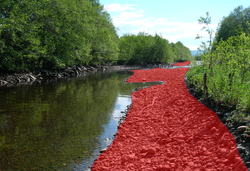Mitigating rapid, short-term variations in flow (hydro-peaking operations)
Contents
Introduction
Hydropeaking refers to hydropower operations that are characterized by more rapid and frequent changes in power production than typical base-load hydropower production. If the water is released into a river, rapid fluctuations in discharge and water level may cause negative impacts to the riverine ecosystem. The severity of the hydropeaking can be categories according to the magnitude of changes in flow, the frequency of the changes, and the timing of the changes, i.e. what time of the day and year the hydropeaking happens.
Bakken et al. (2016) defines measures to reduce the impacts from hydropeaking operations into three types; i) operational measures that involves adjusting the magnitude, speed of change, frequency and timing of change to the better for the ecosystem exposed to hydropeaking, ii) physical changes in the river system downstream the outlet of the hydropower plant, and iii) technical measures directly on the power plant/infrastructure, i.e. a technical setup that allows a wider range of turbine discharges, slower stop and start-up, etc.
The measures presented in the following are all related to changes in flow.
Methods, tools, and devices
During planning
A group of experienced Norwegian scientists summed of a large research project on environmental impacts from hydropeaking operations (CEDREN EnviPEAK - www.cedren.no) by defining a categorisation system for environmentally-adapted hydropeaking operations. The system was developed based on research from EnviPEAK, other similar studies in Norway and across the world, and the expert judgment of the involved scientists. The system was developed primarily based on knowledge about salmonids’ response to hydropeaking. This system is a set of recommendations, seem to have been adopted as standard requirements for hydropeaking operations in Norway, when the environmental terms of operations are revised, or new licences granted. COSH-tool can be used to find the relevant hydropeaking parameters.
The full categorisation system published in Bakken et al. (2016) and Harby et al. (2016) also includes the dimension of assessing the vulnerability of the ecosystem exposed to hydropeaking. The vulnerability is given by assessing factors such as effective population size, degree of limitations in recruitment, habitat degradation, reduced water temperatures and percentage of impacted river length compared to total length. The combined assessment of the effect factors and the vulnerability will give the total and overall impact assessment.
During implementation
If the technical system is properly designed with respect to providing environmentally adapted hydropeaking operations, the introduction of a new flow regime would simply be to release the defined water flows at the right speed and time of the day and year. If the existing infrastructure cannot release support slower ramping rates, adjusted water flow and the flexibility of the frequency and timing, a re-building of the infrastructure might be needed.
During operation
A new flow regime better adapted to the ecosystem tolerance of hydropeaking operations would normally not introduce any extra maintenance. Hydropower operators must normally document that the environmental restrictions are followed, and would have standard monitoring systems (gauging stations) in place. It should be ensured that the monitoring is made with sufficiently high resolution to capture the rapid changes in water flow due to hydropeaking.
The positive environmental effect of the released environmental flow must be surveyed by assessing the development of the fish population, e.g. by monitoring species composition, densities and age structure of populations, number of smolts, etc.
Relevant MTDs and test cases
Classification table
| Classification | Selection |
|---|---|
| Fish species for the measure | All |
| Does the measure require loss of power production | Operational (requires flow release outside turbine) |
| Operational (requires flow release through turbine) | |
| - | |
| Recurrence of maintenance | Never |
| Which life-stage of fish is measure aimed at | Spawning / Recruitment |
| Juveniles | |
| Adult fish | |
| Movements of migration of fish | |
| Which physical parameter is addressed | - |
| - | |
| - | |
| - | |
| - | |
| - | |
| Water velocity | |
| Water depth | |
| Hydropower type the measure is suitable for | Plant in dam |
| Plant with bypass section | |
| Dam height (m) the measure is suitable for | All |
| Section in the regulated system measure is designed for | - |
| - | |
| Bypass section | |
| Downstream outlet | |
| River type implemented | Steep gradient (up to 0.4 %) |
| Fairly steep with rocks, boulders (from 0.4 to 0.05 %) | |
| Slow flowing, lowland, sandy (less than 0.05 %) | |
| Level of certainty in effect | Very certain |
| Technology readiness level | TRL 9: actual system proven in operational environment |
| Cost of solution | See cost table |
Relevant literature
Bakken, T.H., Forseth, T. and Harby, A (Eds) 2016. Miljøvirkninger av effecktkjøring: Kunnskapsstatus og råd til forvaltning og industri (in Norwegian).
Harby, A., Forseth, T., Ugedal, O., Bakken, T.H. and Sauterleute, J. 2016. A method to assess impacts from hydropeaking. Proceedings, 11th International Symposium on Ecohydraulics, Melbourne, Australia.


